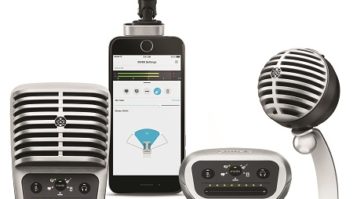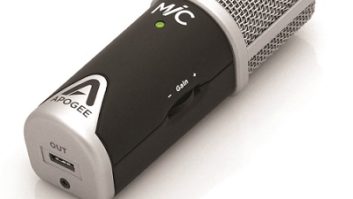
In the picture of NASCAR’s most popular driver Dale Earnhardt Jr., taken at Pocono Raceway in August, you find him besieged by microphones, talking with a gaggle of reporters from print and broadcast outlets. In that situation, radio reporters have but one chance to get the sound they need: radio news gathering in its simplest and most intense form. Welcome to my world.
Microphones used for radio news work are necessarily different than those used by my fellow contributor Ty Ford to work his magic on voice-overs in a studio setting.
In more than 30 years in the field, I’ve seen just about every type of microphone used to record voice tracks, actualities and natural sound; from the onboard electrets built into cassette machines (which usually happens when a mic and/or cable is forgotten); to an Electro-Voice RE20 brought by a star-struck country music DJ from Scranton, Pa., who shall remain nameless; to a NASCAR Sprint Cup event at Pocono.
In most cases, using a separate microphone improves the sonic quality of the recording. Some of the new miniature digital handheld recorders have better-than-average microphones built in — the Olympus LS-10 comes immediately to mind — which makes for a nice backup to a separate microphone if you’re so inclined.
Microphonic ramblings

Dale Earnhardt Jr. faces a sea of microphones (and handheld recorders) at the Pocono Raceway. Microphones for news work usually are used handheld (for reporter voice work, interviews and miking speakers in case a mult box is not available or full), or on a portable stand.
If you use a microphone that’s prone to handling noise, a portable stand will eliminate that particular barrier to good sound. I have a folding stand that I’ve used since 1980, the AKG LM 231-1.
Condenser microphones for news work (shotguns, for instance) add powering issues (phantom or battery; depends on the microphone). Omnidirectional microphones seem to work better in a run-and-gun situation; directional mics (those that pick up sound more toward the front of the microphone than the sides and rear) will give the recording a little more presence, but you’ll need more time to aim and steady the microphone so potential handling noise is reduced or eliminated.
Handling noise even prompted some action by one of the smartest guys in the audio industry.
Bob Heil of Heil Sound was one of the people managers of bands like The Who and The Grateful Dead called, back in the day, when concert sound moved into the modern era. Bob now makes microphones for radio applications (used by Tom Joyner and Art Bell among others), and for us in the field, handheld microphones. He’s an amateur radio operator (K9EID) so you might get your question answered next time you are DXing.
His association with Joe Walsh was the genesis for the PR 20 vocal microphone. The PR 22 is the next generation of that vocal microphone, with the same flat 50 Hz–18 kHz frequency response and drastically reduced handling noise.
Bob says the PR 20 had some handling noise because of the extended frequency response.

Heil Sound PR 22 “It’s not a problem when [the microphone is] used on a stand, as we do for so many artists and in studios.” Bob studied the handling noise problem and after 18 months, hit upon a fix. He calls it an “Iso-Band,” which consists of a suspension mount (for the mic element) made of silicone and Sorbothane rubber.
“It isolates the 60 Hz to 100 Hz frequencies (generated by movement of the mic) from reaching the element.” When in a scrum as illustrated in the picture, that isolation can make the difference between just getting the sound, and getting better quality sound.
Why is this important? When reporters fed most of their submissions by POTS dial-up phone lines, the low frequencies would naturally roll off. Now, with FTP and e-mailed file distribution and POTS/ISDN/IP codecs, extended frequency response is the norm; too much handling noise could pose a distraction for listeners.
Preparing this column, I put aside the microphones I use normally — Audio-Technica AT897 shotgun, Shure SM63, Shure SM77 — and got to play with Heil’s PR 22, Handi Mic Pro Plus and a prototype of the yet-to-be-released PR 60.
The Handi Mic Pro Plus is a go-anywhere cardioid microphone. Those assembling a road kit may look at this as a backup mic that takes up little to no space (4.5 inches in length; seven ounces in weight), and it has a frequency response of 80 Hz–15 kHz. The PR 60 is a work in progress; Bob says the unit was developed in response to a request from a TV station in Chicago.
Another mic that comes to mind is the Sennheiser MD46, reviewed here back in 2001. Steve Richards from Performance Racing Network swears by the MD46, whether he’s recording sound in a group setting, or cutting a voice track for PRN’s “Garage Pass” program.
One can see a variety of microphones — from Electro-Voice’s “Buchanan Hammer,” the 635A, to Shure’s SM58 and other units that have solved problems for their users on the road. I will explore the topic of microphones for newsgathering further in a future column. Your input as to suitable angles to explore is appreciated.
Hang weight

Small but always useful: Don’t leave home without this little stand. When microphone cords are being fabricated or considered for audio recorders with 3.5 mm (1/8-inch) TRS connectors, the concept of hang weight needs to be addressed.
If a mic cord is constructed with a standard microphone cable that one might use for XLR connections, the weight of the cord (hang weight) will, over time, act like a lever on the end of the plug. That has the effect of opening the microphone jack inside the recorder to the point that proper contact with the 3.5 mm TRS plug cannot be maintained. The longer the cord and heavier the wire, the more likely and sooner this will happen.
I learned about this the hard way with a Marantz PMD201 cassette recorder a number of years back.
The way to combat this is to construct mic cords for the 3.5 mm TRS jacks with light and strong microphone cable, which I began to do out of economy’s sake. If constructing such cords, do the user a favor: For the XLR connector do not use connectors that have set screws to locate the insert inside the shell; those set screws come loose over time and they do so at most inconvenient times. Most reporters don’t carry a “greenie” to tighten up those little screws.
Next time I will discuss power options for road warriors — alkaline, lithium or rechargeable NiMH batteries. If there’s a radio newsgathering operational or equipment topic you’d like to have us look at in a future column, you can send those suggestions by e-mail to me or to [email protected].
Just a reminder: If I mention the brand name of an item used by another news organization in these columns, that mention is not, nor should it be considered as, an endorsement by the news organization.
Paul Kaminski is news director for the Motor Sports Radio Network and a contributor for CBS News Radio; he has been a Radio World contributor since 1997. E-mail to [email protected].






